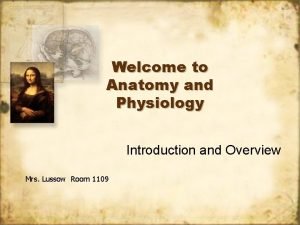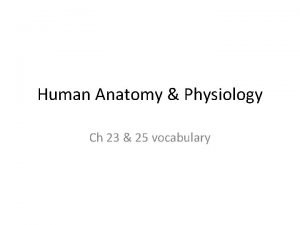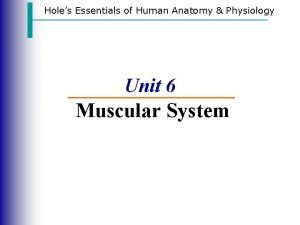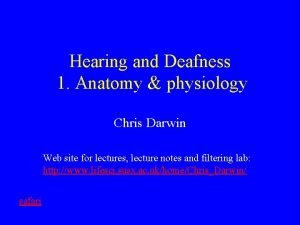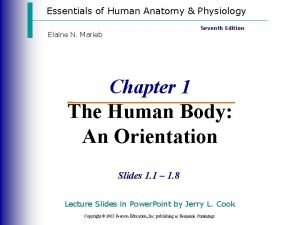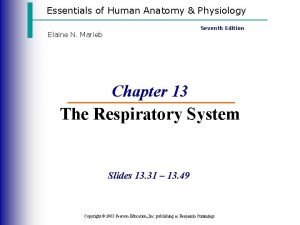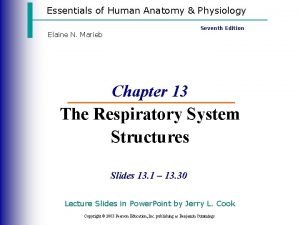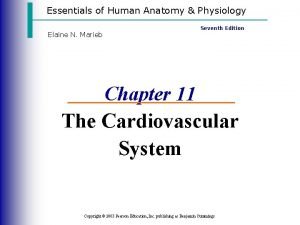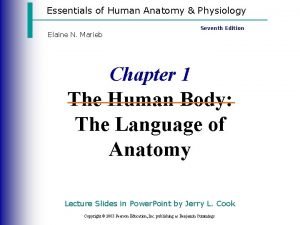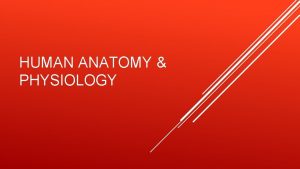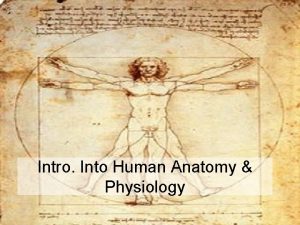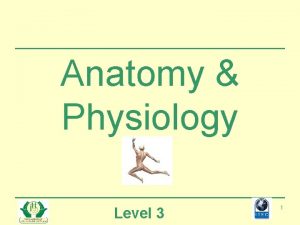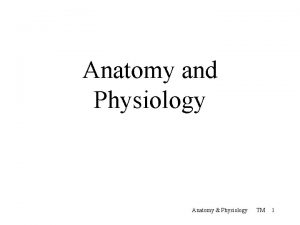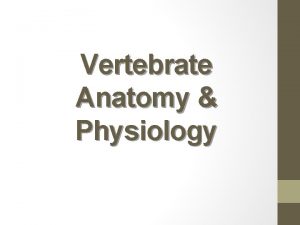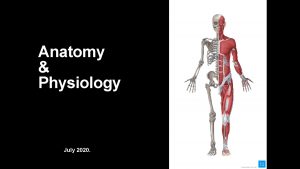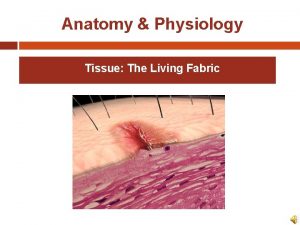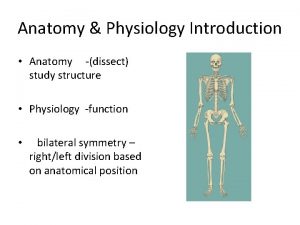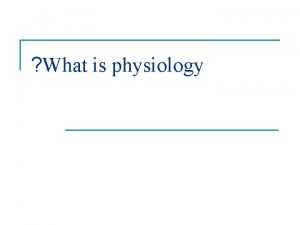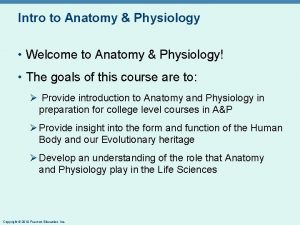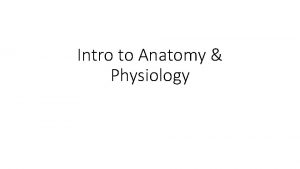Human Anatomy and Physiology Chapter 1 I Overview































































- Slides: 63

Human Anatomy and Physiology Chapter 1

I. Overview of Anatomy and Physiology • __________= the study of the s and shape of the body and its parts and their relationships to one another…. . large body structures gross anatomy • v. _________anatomy(too small to be seen w/o a microscope) Anatomy Microscopic

Physiology Neuron physiology Cardiac physiology • ____________study of how body and its parts work or function in nature…. many subdivisions, like____________ and _______________ • Relationships between Anatomy and Physiology • The 2 are always related…Structures determine what functions can take place

II. Levels of Structural Organization chemical molecules • At the ___________level atoms combine to make __________. • At the _________ level, _____are composed of molecules. • At the ____________, it is made of the same type of cells, functioning together. cellular cells Tissue level

• • • At the __________level, different tissues work together for a common function. At the organ system level different organs work together closely. the highest level is the organism organ



A. Organ System Overview – __________________=external covering of the body; waterproofs, cushions and protects: excretes salts and urea in perspiration and helps regulate body ________. Temp, pressure and pain receptors in the skin alert us at the body surface. Integumentary system temperature

Skeletal System • _________________=consists of bones, cartilage, ligaments and joints. supports body and provides framework for skeletal muscle also protects…. __________ formation of blood cells takes place in bone marrow ; also storehouse for minerals Hematopoiesis

Muscular system – ________________=Contract or shorten to produce movement of body skeletal muscles or w/in organs cardiac or smooth muscles – ________________=has brain, spinal cord , nerves and sensory receptors as control system Nervous system

• ________= controls body through hormonal control. Endocrine release hormones chemicals into the blood and they go to a target organ. These glands inc. the pituitary, thyroid, parathyroid, adrenals, thymus, pancreas, pineal, ovaries, and testes. What is controlled includes growth, reproduction and food used by cells. Endocrine System

Cardiovascular System – ______includes the heart and blood vessels and blood, transporting oxygen and nutrients, hormones, etc…. wbcs protect – Lymphatic System inc. lymphatic vessels, lymph nodes organs , such as the spleen and tonsils. The vessels return fluid leaked from the blood back to blood…the nodes help clean the blood and are involved in immunity.

• ________ Basically a tube running through the body from mouth to anus inc. mouth, esophagus, stomach, sm. and lg. intestine, and rectum—Break down food and deliver the products to blood so it will go to cells undigested returns to be eliminated as feces Digestive System

– Urinary System-removes nitrogen containing wastes from blood and excretes as urine--maintains body’s water and salt balance—inc. kidneys, ureters, bladder, urethra – Reproductive System-to produce offspring----testes male/ovaries-female









III. Maintaining Life • LIFE FUNCTIONS_ • Maintaining Boundaries keep inside separate from outside – Cells have membranes – Body is surrounded by _________ as will as does the internal organs. Integumentary system

• B. Movement. –promoted by muscular system- walking, etc…. using fingers…. and bones provide support – Movement also happens as________________are propelled through the organs Substances such as blood

• C. __________ or Irritability is the ablity to sense changes (stimuli) in environment) and react • Nerve cells highly irritable • Other parts of your body respond to stimuli responsiveness

• D. Digestion-breaking down food into simple molecules to be absorbed into the blood, which goes to your body cells

• E. ______ refers to all chemical reactions that occur w/in body cells makes nutrients and oxygen available to the blood and on the cardiovascular system to distribute needed substances throughout the body regulated greatly by hormones metabolism

indigestable • F. Excretion process of removing wastes from body removes nonuseful substances produced during digestion and metabolism feces from _______digestion leftovers • G. ________ Production of offspring • H. _____is an increase in size—cells must be created taster than destroyed reproduction growth

SURVIVAL NEEDS Maintain life • The goal of most body systems is to _________. These fragile __________ include the following: – 1 ________ body takes in as food and chemical reactions release energy from it using O 2. Carb’s are the main energy source…. . Proteins provide nutrients and fats build cell structures , a last source for energy and cushion organs. Survival needs nutrients

O 2 – 2 -________ is necessary to derive • most energy It is required in Cellular respiration…. . it is in 20% of the air we breathe. . It is also circulated to blood and cells by respiratory and cardio vascular systems 3 Water is 60 80 % body weight most important molecule in the body and is the solvents for secretions and excretions…. comes mostly from ingested foods and liquids and lost evaporation from lungs and skin and excretions

Temperature – 4 ___________must remain at around 37 degrees C (98 F). If it is too slow, metabolism stops and too high, proteins break down…. . death occurs at either extreme. – 5 Atmospheric Pressure is the force on the surface of the body by the weight of air--atmospheric pressure----Too high altitudes may have gas exchange too low for metabolism

IV. HOMEOSTASIS—body’s ability to maintain stable internal conditions(even though outside world changes) • The body is DYNAMIC within narrow limits • All organ systems involved examples; Nutrient blood levels, heart activity and blood pressure, , waste eliminated and body temp.

• Homeostatic Control Mechanisms: • 3 components what is regulated is called the variable • 1 ____________sensor that monitors and changes in environment • 2 ____________ Flows to here along afferent pathway determines appropriate response or reaction. • 3 Effector provides output to stimulus along efferent pathway results feed back to influence stimulus turning off NEGATIVE or turn on positive feed back Most body mechanism are negative feed back. receptor Control center








Directional terms allow medical personal to describe exactly where one structure is in relationship to another. They include the following: • • Superior-(cranial or cephalad)toward head or upper part Inferior- away from head or lower part Ventral-(anterior)front of body----front of Dorsal-(posterior)backof body-back of Medial- toward or at body midline; inner side Lateral- away from midline; on the outer side proximal-close to origin of body part or where it is attached • distal-farther from origin • superficial(external)---toward or at body surface • Deep(internal) away from body surface-more internal

Regional Terms Visible body landmarks see figure 1. 5 p. 16 label in notes • ANTERIOR____ – – – – Abdominal ---anterior trunk below ribs Acromial----(Point) of shoulder Antebrachial-forearm Antecubital-ant. Surface of elbow Axillary-armpit Brachial arm Buccal-cheek Carpal-wrist Cervical --neck region Coxal-hip Crural leg Deltoid-curve of shoulder formed by lg deltoid muscle Digital—fingers, toes

– – – – Femoral---thigh Fibular---lateral part of leg Frontal –forehead Inguinal-groin Nasal Orbital-eye Patellar-knee Pubic-genital Sternal breastbone Tarsal-ankle Thoracic-chest Umbilical-naval

POSTERIOR____ • • • Calcaneal-heel Cephalic-head Femoral-thigh Gluteal-buttock Lumbar---back area between ribs and hips Occipital-back of head Olecranal-post. Surface of elbow Popliteal-post. Knee area Sacral-area between hips Scapular---shoulder blades



BODY PLANES AND SECTIONS • In anatomy , students make sections or cuts it is made along an imaginary line or _____. . . . being 3 D, we consider 3 types of planes – Sagittal section is lengthwise or longitudinally If the right and left parts are equal it is median or midgasittal – Frontal section is lengthwise into ant. And post parts also called coronal – a Tranverse Section is cut along a horizontal plane, making superior and inferior parts also called cross section plane




Orientation and Directional Terms Table 1. 1


Orientation and Directional Terms Table 1. 1 (cont)








BODY CAVITIES • Dorsal cavity has 2 subdivisions: • cranial-in skull and • spinal cavity-extends from cranial to end of vertebral column

• Ventral body Cavity • Much larger; contains all in chest and abdomen – Thoracic cavity(lungs, heart…. separated by diaphragm MEDIASTINUM serarates right and left cavities – Abdominopelvic cavity stomach, liver, intestines (superior) • • inferior Pelvic cavity reproductive organs

• • • List the 9 separate regions separated by 4 planes ________________________ _____________________________ _________________ Umbilical region Epigastric region Hypogastric(pubic )region Right and left iliac or inguinal region Right and left lumbar regions Right and left hypochondriac regions
 Chapter 1 introduction to human anatomy and physiology
Chapter 1 introduction to human anatomy and physiology Medial lateral distal proximal
Medial lateral distal proximal Chapter 2 human reproductive anatomy and physiology
Chapter 2 human reproductive anatomy and physiology 3 layers of muscle
3 layers of muscle Holes essential of human anatomy and physiology
Holes essential of human anatomy and physiology Uterus perimetrium
Uterus perimetrium Anatomy and physiology edition 9
Anatomy and physiology edition 9 Chapter 14 anatomy and physiology
Chapter 14 anatomy and physiology Anatomy and physiology chapter 8 special senses
Anatomy and physiology chapter 8 special senses Chapter 13 anatomy and physiology of pregnancy
Chapter 13 anatomy and physiology of pregnancy Chapter 2 basic chemistry anatomy and physiology
Chapter 2 basic chemistry anatomy and physiology Chapter 7 anatomy and physiology
Chapter 7 anatomy and physiology Chapter 14 the digestive system and body metabolism
Chapter 14 the digestive system and body metabolism Chapter 10 blood anatomy and physiology
Chapter 10 blood anatomy and physiology Anatomy and physiology chapter 15
Anatomy and physiology chapter 15 Anatomy and physiology chapter 1
Anatomy and physiology chapter 1 Holes anatomy and physiology chapter 1
Holes anatomy and physiology chapter 1 Anatomy and physiology chapter 15
Anatomy and physiology chapter 15 Appendicular skeleton pectoral girdle
Appendicular skeleton pectoral girdle Chapter 6 general anatomy and physiology
Chapter 6 general anatomy and physiology Anterior posterior ventral dorsal
Anterior posterior ventral dorsal Pulmonary tract
Pulmonary tract Tattoo anatomy and physiology
Tattoo anatomy and physiology International anatomy olympiad
International anatomy olympiad Structure anatomy and physiology in agriculture
Structure anatomy and physiology in agriculture Bone anatomy and physiology
Bone anatomy and physiology Pud triple therapy
Pud triple therapy Liver anatomy and physiology
Liver anatomy and physiology Podbřišek
Podbřišek Epigastric region
Epigastric region Google
Google Http://anatomy and physiology
Http://anatomy and physiology Anatomy and physiology of appendix
Anatomy and physiology of appendix Aohs foundations of anatomy and physiology 1
Aohs foundations of anatomy and physiology 1 Aohs foundations of anatomy and physiology 2
Aohs foundations of anatomy and physiology 2 Anatomy and physiology of swine
Anatomy and physiology of swine Teks anatomy and physiology
Teks anatomy and physiology Science olympiad anatomy and physiology 2020 cheat sheet
Science olympiad anatomy and physiology 2020 cheat sheet Gastric emptying ppt
Gastric emptying ppt Anatomy and physiology of diabetes
Anatomy and physiology of diabetes Aohs foundations of anatomy and physiology 1
Aohs foundations of anatomy and physiology 1 Aohs foundations of anatomy and physiology 1
Aohs foundations of anatomy and physiology 1 Anatomy and physiology
Anatomy and physiology Cornell notes for anatomy and physiology
Cornell notes for anatomy and physiology Anatomy and physiology unit 7 cardiovascular system
Anatomy and physiology unit 7 cardiovascular system Anatomy and physiology
Anatomy and physiology The speed at which the body consumes energy
The speed at which the body consumes energy Aohs foundations of anatomy and physiology 1
Aohs foundations of anatomy and physiology 1 Anatomy and physiology exam 1
Anatomy and physiology exam 1 Welcome to anatomy and physiology
Welcome to anatomy and physiology Physiology of the foot and ankle
Physiology of the foot and ankle Skin cancer
Skin cancer Pancreas anatomy and physiology
Pancreas anatomy and physiology Anatomy and physiology vocabulary
Anatomy and physiology vocabulary Anatomy and physiology
Anatomy and physiology Biceps muscle names
Biceps muscle names Anatomy and physiology
Anatomy and physiology Body landmarks diagram
Body landmarks diagram Anatomy and physiology
Anatomy and physiology Anatomy and physiology
Anatomy and physiology Anatomy and physiology
Anatomy and physiology Dorsifelxion
Dorsifelxion Anatomy and physiology
Anatomy and physiology Anatomy and physiology
Anatomy and physiology

















































